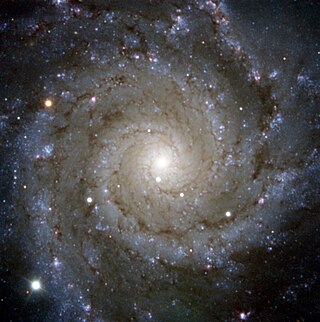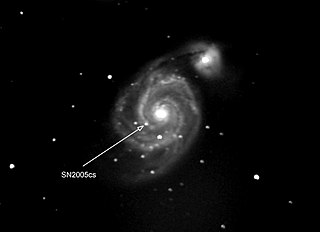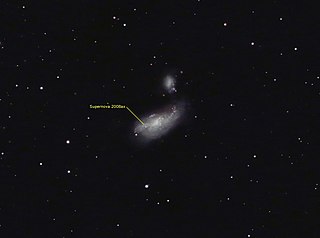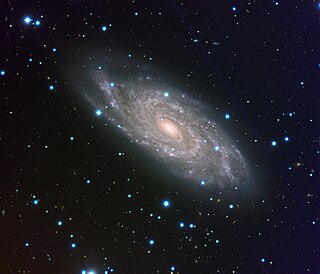
A supernova is a powerful and luminous explosion of a star. A supernova occurs during the last evolutionary stages of a massive star, or when a white dwarf is triggered into runaway nuclear fusion. The original object, called the progenitor, either collapses to a neutron star or black hole, or is completely destroyed to form a diffuse nebula. The peak optical luminosity of a supernova can be comparable to that of an entire galaxy before fading over several weeks or months.

The Whirlpool Galaxy, also known as Messier 51a (M51a) or NGC 5194, is an interacting grand-design spiral galaxy with a Seyfert 2 active galactic nucleus. It lies in the constellation Canes Venatici, and was the first galaxy to be classified as a spiral galaxy. It is 7.22 megaparsecs away and 23.58 kiloparsecs (76,900 ly) in diameter.

Messier 81 (also known as NGC 3031 or Bode's Galaxy) is a grand design spiral galaxy about 12 million light-years away in the constellation Ursa Major. It has a D25 isophotal diameter of 29.44 kiloparsecs (96,000 light-years). Because of its relative proximity to the Milky Way galaxy, large size, and active galactic nucleus (which harbors a 70 million M☉ supermassive black hole), Messier 81 has been studied extensively by professional astronomers. The galaxy's large size and relatively high brightness also makes it a popular target for amateur astronomers. In late February 2022, astronomers reported that M81 may be the source of FRB 20200120E, a repeating fast radio burst.

Messier 74 is a large spiral galaxy in the equatorial constellation Pisces. It is about 32 million light-years away from Earth. The galaxy contains two clearly defined spiral arms and is therefore used as an archetypal example of a grand design spiral galaxy. The galaxy's low surface brightness makes it the most difficult Messier object for amateur astronomers to observe. Its relatively large angular size and the galaxy's face-on orientation make it an ideal object for professional astronomers who want to study spiral arm structure and spiral density waves. It is estimated that M74 hosts about 100 billion stars.

NGC 6946, sometimes referred to as the Fireworks Galaxy, is a face-on intermediate spiral galaxy with a small bright nucleus, whose location in the sky straddles the boundary between the northern constellations of Cepheus and Cygnus. Its distance from Earth is about 25.2 million light-years or 7.72 megaparsecs, similar to the distance of M101 in the constellation Ursa Major. Both were once considered to be part of the Local Group, but are now known to be among the dozen bright spiral galaxies near the Milky Way but beyond the confines of the Local Group. NGC 6946 lies within the Virgo Supercluster.
Leuschner Observatory, originally called the Students' Observatory, is an observatory jointly operated by the University of California, Berkeley and San Francisco State University. The observatory was built in 1886 on the Berkeley campus. For many years, it was directed by Armin Otto Leuschner, for whom the observatory was renamed in 1951. In 1965, it was relocated to its present home in Lafayette, California, approximately 10 miles (16 km) east of the Berkeley campus. In 2012, the physics and astronomy department of San Francisco State University became a partner.

SN 2005cs was a supernova in the spiral galaxy M51, known as the Whirlpool Galaxy. It was a type II-P core-collapse supernova, discovered June 28, 2005 by Wolfgang Kloehr, a German amateur astronomer. The event was positioned at an offset of 15″ west and 78″ south of the galactic nucleus of M51. Based on the data, the explosion was inferred to occur 2.8 days before discovery. It was considered under-luminous for a supernova of its type, releasing an estimated 3×1050 erg in energy.

SN 1994D was a Type Ia supernova event in the outskirts of galaxy NGC 4526. It was offset by 9.0″ west and 7.8″ south of the galaxy center and positioned near a prominent dust lane. It was caused by the explosion of a white dwarf star composed of carbon and oxygen. This event was discovered on March 7, 1994 by R. R. Treffers and associates using the automated 30-inch telescope at Leuschner Observatory. It reached peak visual brightness two weeks later on March 22. Modelling of the light curve indicates the explosion would have been visible around March 3-4. A possible detection of helium in the spectrum was made by W. P. S. Meikle and associates in 1996. A mass of 0.014 to 0.03 M☉ in helium would be needed to produce this feature.

NGC 1309 is a spiral galaxy located approximately 120 million light-years away, appearing in the constellation Eridanus. It is about 75,000 light-years across, and is about 3/4s the width of the Milky Way. Its shape is classified as SA(s)bc, meaning that it has moderately wound spiral arms and no ring. Bright blue areas of star formation can be seen in the spiral arms, while the yellowish central nucleus contains older-population stars. NGC 1309 is one of over 200 members of the Eridanus Group of galaxies.

Type Ib and Type Ic supernovae are categories of supernovae that are caused by the stellar core collapse of massive stars. These stars have shed or been stripped of their outer envelope of hydrogen, and, when compared to the spectrum of Type Ia supernovae, they lack the absorption line of silicon. Compared to Type Ib, Type Ic supernovae are hypothesized to have lost more of their initial envelope, including most of their helium. The two types are usually referred to as stripped core-collapse supernovae.

A Type II supernova or SNII results from the rapid collapse and violent explosion of a massive star. A star must have at least eight times, but no more than 40 to 50 times, the mass of the Sun (M☉) to undergo this type of explosion. Type II supernovae are distinguished from other types of supernovae by the presence of hydrogen in their spectra. They are usually observed in the spiral arms of galaxies and in H II regions, but not in elliptical galaxies; those are generally composed of older, low-mass stars, with few of the young, very massive stars necessary to cause a supernova.

SN 1993J is a supernova observed in Bode's Galaxy. It was discovered on 28 March 1993 by F. Garcia in Spain. At the time, it was the second-brightest type II supernova observed in the twentieth century behind SN 1987A, peaking at a visible apparent magnitude of 10.7 on March 30, with a second peak of 10.86 on April 18.
SN 1990U was a type Ic supernova event in the nucleus of the galaxy NGC 7479. It was discovered July 27, 1990 by the Berkeley Automated Supernova Search after reaching magnitude 16±0.5. Initially this was classified as a Type Ib supernova, but the weakness of the neutral helium absorption lines led to a reclassification.

SN 2008ax was a helium-rich type Ib core-collapse supernova in the interacting galaxy NGC 4490. It was independently discovered on 3 March 2008 by LOSS and 4 March by Koichi Itagaki. The site had been monitored six hours before discovery, thus constraining the time of the explosion breakout. It was the third-brightest supernova of 2008. The brightness in the B-band peaked about 20 days after the explosion. X-ray emissions were detected from the event, which are most likely the result of shock heating from the supernova ejecta and circumstellar material.

NGC 7424 is a barred spiral galaxy located 37.5 million light-years away in the southern constellation Grus. Its size makes it similar to our own galaxy, the Milky Way. It is called a "grand design" galaxy because of its well defined spiral arms. Two supernovae and two ultraluminous X-ray sources have been discovered in NGC 7424.

NGC 6118 is a grand design spiral galaxy located 83 million light-years away in the constellation Serpens. It was discovered on 14 April 1785 by German-British astronomer William Herschel.
SN 2011dh was a supernova in the Whirlpool Galaxy (M51). It was discovered on 31 May 2011, with an apparent magnitude 13.5. and confirmed by several sources, including the Palomar Transient Factory. A candidate progenitor was detected in Hubble Space Telescope images. The progenitor may have been a highly luminous yellow supergiant with an initial mass of 18-24 solar masses. The supernova peaked near apparent magnitude 12.1 on 19 June 2011. Emission spectra indicated that the explosion was a type II supernova, in which a massive star collapses once nuclear fusion has ceased in its core.

SN 2014J was a type-Ia supernova in Messier 82 discovered in mid-January 2014. It was the closest type-Ia supernova discovered for 42 years, and no subsequent supernova has been closer as of 2023. The supernova was discovered by chance during an undergraduate teaching session at the University of London Observatory. It peaked on 31 January 2014, reaching an apparent magnitude of 10.5. SN 2014J was the subject of an intense observing campaign by professional astronomers and was bright enough to be seen by amateur astronomers.

A hypernova is a very energetic supernova which is believed to result from an extreme core collapse scenario. In this case, a massive star collapses to form a rotating black hole emitting twin astrophysical jets and surrounded by an accretion disk. It is a type of stellar explosion that ejects material with an unusually high kinetic energy, an order of magnitude higher than most supernovae, with a luminosity at least 10 times greater. Hypernovae release such intense gamma rays that they often appear similar to a type Ic supernova, but with unusually broad spectral lines indicating an extremely high expansion velocity. Hypernovae are one of the mechanisms for producing long gamma ray bursts (GRBs), which range from 2 seconds to over a minute in duration. They have also been referred to as superluminous supernovae, though that classification also includes other types of extremely luminous stellar explosions that have different origins.

SN 2020oi was a supernova event in the grand design spiral galaxy known as Messier 100, or NGC 4321. It was discovered January 7, 2020 at an apparent magnitude of 17.28 by F. Forster and associates using the Zwicky Transient Facility. The position places it ~4.67″ north of the galactic nucleus. The supernova was not detected on an observation made three days before the discovery, and thus it must have begun during that brief period. The light curve peaked around January 13–18, depending on the wavelength, then declined rapidly over a period of 25 days before flattening into a more gradual decline. Observations of the spectrum made with the SOAR telescope showed this to be a type Ic supernova, with the progenitor being a massive star that had its outer envelope stripped. The initial velocity of the expanding photosphere was ~15,000 km/s.
















